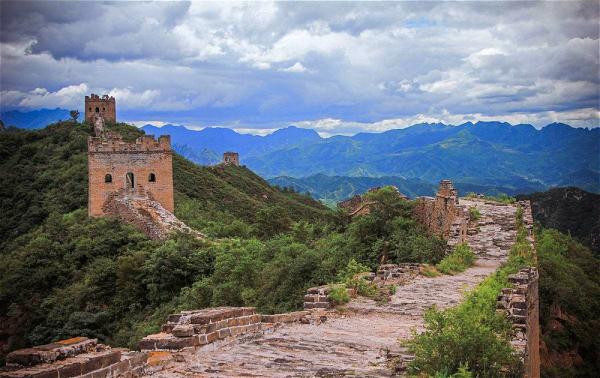The Great Wall of China: Everything You Need to Know
There is a famous saying in China, “He who doesn't reach the Great Wall of China is not a true man.” So, what is the Great Wall? It is an ancient Chinese military fortification, which is a tall, strong and continuous wall used to limit the movement of enemy riders. The Great Wall is not just an isolated wall, but a defence system with a wall as the main body, combined with a large number of cities, barriers, pavilions and markers.
As the most recognizable symbol of China, the Great Wall not only carries the profound Chinese culture, but also reflects the great spirit of Chinese nation. >> Understand the Symbolic Meaning of the Great Wall
In December 1987, the Great Wall was listed as a World Heritage Site.

Quick Facts of the Great Wall of China
The History of the Great Wall
The history of the construction of the Great Wall dates back to the Western Zhou Dynasty. The famous story of ‘Beacon Fire Playing with the Lords’, which took place in Haojing (present-day Xi'an), originated here.
During the Spring and Autumn and Warring States Periods, the Great Wall was built into the first climax as the powers were fighting for supremacy and defending each other. However, the length of the Great Wall was relatively short at this time. In the Qin Dynasty, after the six states were destroyed and China was unified, Emperor Qin Shi Huang connected and repaired the Great Wall, which became known as the Great Wall of Ten Thousand Miles. The Ming Dynasty was the last dynasty to repair the Great Wall, and most of the Great Wall people saw was built at this time.
According to historical records, from the seventh century B.C., when the State of Chu built the ‘Square City’, to the Ming Dynasty (1368-1644), a total of more than 20 vassal states and feudal dynasties built the Great Wall. The length of the Great Wall during the Qin, Han and Ming dynasties exceeded 5,000 kilometers.
Recommended Great Wall of China Tours:
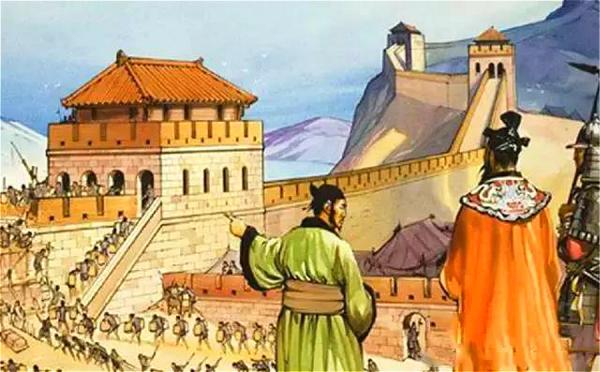
Who Built the Great Wall of China?
The first to build the Great Wall was the State of Chu, which began to build the Great Wall as a defence against nomads or enemy states in the north. Subsequently, during the Warring States period, Qi, Yan, Wei, Zhao, and Qin began to build their own Great Walls for the same purpose. After the unification of the six states by Qin, Qin Shi Huang sent his famous general Meng Tien on a northern expedition against the Xiongnu, connecting the Great Walls of all the states.
The construction of the Great Wall continued during the Han Dynasty. From Emperor Wen to Emperor Xuan, the Great Wall was built to a length of nearly 10,000 kilometres, starting from the city of Ershi in Dawan in the west and ending on the northern shore of the Heilongjiang River in the east. Half of the ancient Silk Road trip followed this Great Wall, which was the longest Great Wall in Chinese history.
During the Ming Dynasty, the Great Wall was constructed 20 times from the reign of Hongwu to the reign of Wanli in order to defend against Tartar and Washu tribes.
How Long is the Great Wall of China?
Like a huge dragon, the Great Wall winds its way through deserts, basins, plains and mountains of North China extending about 21196.18 kilometers (13170.7 miles). It begins in the east at Shanhaiguan and ends at Jiayuguan in the west. So in Chinese, the Great Wall is also called “Wan Li Chang Cheng”, literally means “the long wall of 10000 Li” (Chinese unit of distance 2 Li=1 km).
Where is the Great Wall of China?
The Great Wall is mainly located in 15 provinces, autonomous regions and municipalities directly under the central government, including Hebei, Beijing, Tianjin, Shanxi, Shaanxi, Gansu, Inner Mongolia, Heilongjiang, Jilin, Liaoning, Shandong, Henan, Qinghai, Ningxia and Xinjiang. Among them, the length of Hebei Province is 2498.54 kilometres, and the length of Shaanxi Province is 1838 kilometres. The total length of the Ming Great Wall is 8,851.8 kilometres, and the Qin-Han and early Great Walls exceed 10,000 kilometres.
Why the Great Wall Was Built?
The Great Wall of China is a series of stone and earthen fortifications in China, built and rebuilt to protect the northern borders of the Chinese Empire during the rule of successive dynasties. It originated from several separate walls built by the small kingdoms to protect their own territories during China's Warring States Period (475-221 B.C.). After the whole country was unified in 220 B.C. by the first Emperor Qin Shi-huang, he ordered his general Meng Tian to force 300,000 labours to extend and connect the north sections of these walls to keep away the invasion from nomadic tribes. At the successive dynasties like Han (202 B.C.-220 A.D.), Ming (1368-1644 A.D.) dynasties, large scale of constructions were implemented as the diplomatic relations with northern nomadic tribes remained unfavorable or instable.
What is the Great Wall of China Made of? How It Was Constructed
You can imagine, in that age of no modern machines, how hard it was to complete this huge project. More than 100 million tons of stone, bricks and soil were transported and assembled to the dangerous top of the mountains by almost all available labours of the country, including soldiers, peasants and prisoners, using basic rope, wood, with the help of animals, and some fundamental mechanical and physical methods.
According to history and legend, there were mainly 3 ways to transport all the materials up to the mountains and across the plains and deserts: carried by hands, used the primitive technology by wheel barrows, logs and ropes, and used oxen and horse in flat areas, goats on steep mountains, camels in deserts for delivering materials.

The Design Principles of the Great Wall
As we can see, the landform where the Great Wall lies is very complicated and variable, changing from mountains to plains, from desert to riverbank. And the designers made a clever use of these terrains, and built the walls at strategic locations, in order to repel the invaders effectively, and took advantage of rivers and cliffs as natural barriers, which could also save lots of labor and materials.
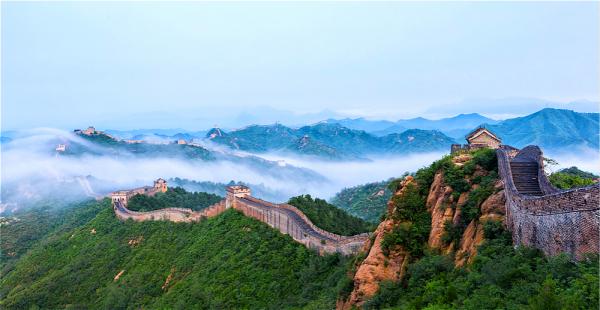
The Architecture System of the Great Wall
The Great Wall of China is never been an isolated wall, but an extremely elaborate and rigorous defense system of construction. For example, the watchtowers on the hilltop vantage point were using for observation, and the beacon towers were using for communication, once an emergency aroused, the troops stationed along the Great Wall would light signal fires one by one. Besides, the fortresses were using as command posts and logistics. And there’re other auxiliary facilities. >> Read more about Why the Great Wall of China is Deemed to a System
The Most Popular Sections of the Great Wall
The most famous remaining sections of the Great Wall today were mainly built in Ming Dynasty, which were better preserved compared with other older walls. Many of them are located in the north of Beijing like Juyong Pass, Badaling, Mutianyu, Jinshanling and Simatai.
Badaling Great Wall
Badaling Great Wall is the most well-preserved and the most visited section of the Great Wall. It was reconstructed during the Ming Dynasty (1368-1644), commanding a strategic position for transportation and defense in ancient times. Badaling Great Wall is 3,741 meters long (2.3 miles) with an average height of 8 meters (26 feet). The highest point of it is about 1,015 meters (3,330 ft) above sea level. It was the first section of the Great Wall to open for tourism in 1957.
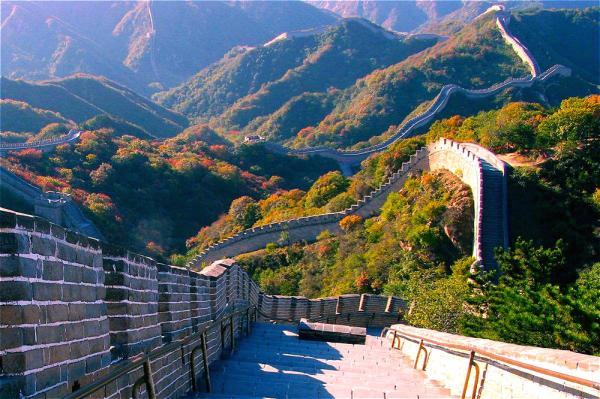
Mutianyu Great Wall
Located 43 miles (70 km) northeast of Beijing, Mutianyu Great Wall is 1.4 miles (2,250m) long, 26 feet (7-8m) high and 20 feet (4-6m) wide. Its specialty relays on 22 blockhouses and watchtowers on it. Climbing up into a number of watchtowers, tourists can have a bird's eye view of the snake wall and its surrounding area.
Recommended tour: Private Beijing Great Wall Day Tour

Jinshanling Great Wall
Located 125 km northeast of Beijing,Jinshanling Great Wall is a bit more remote and isolated than the standard and crowded sections of the Great Wall like Badaling. It is 10.5 km long with 5 passes, 67 towers and 2 beacon towers. The Jinshanling section was built from 1570 CE during the Ming Dynasty. Different from other sections of the Great Wall, Jinshanling Great Wall located in the mountainous area in Luanping County.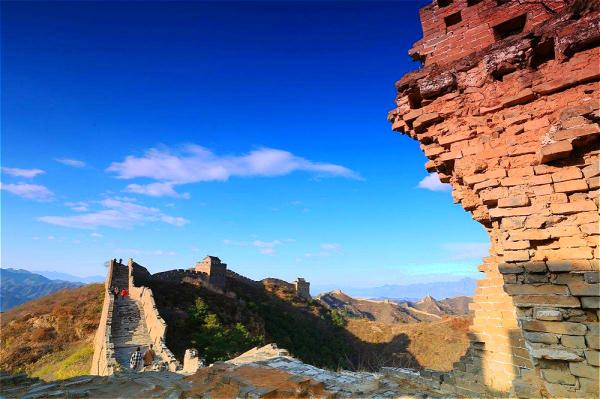
Simatai Great Wall
Unlike the Badaling and Mutianyu sections of the Great Wall, Simatai section is more authentic.
It has not been renovated or restored since it was built 500 years ago. Thus, it is the only section of the Great Wall that retains all the original features of the Ming Dynasty wall. Date on which they were made and the code numbers of the armies that made them can still be seen on the bricks of Simatai Great Wall.
